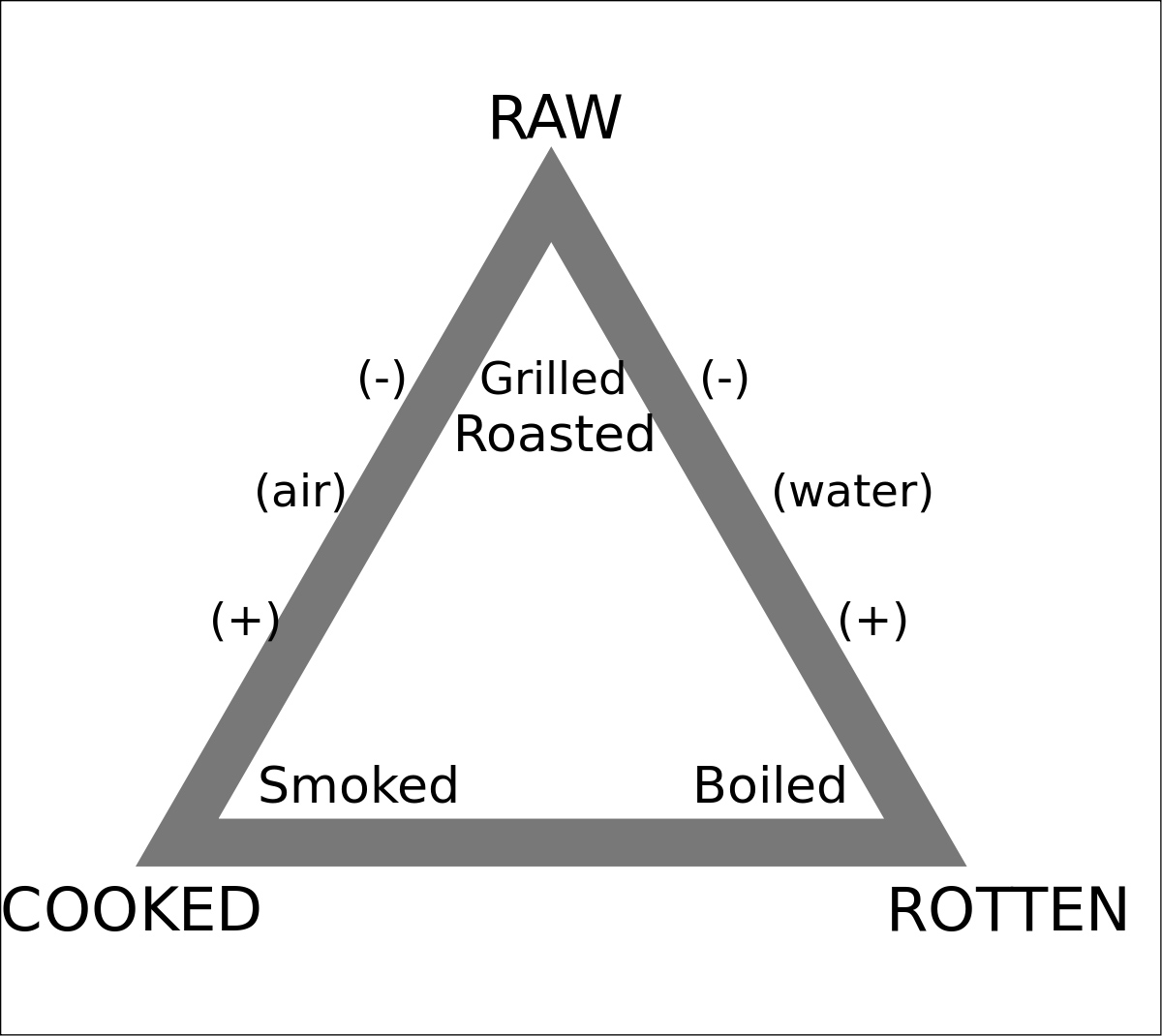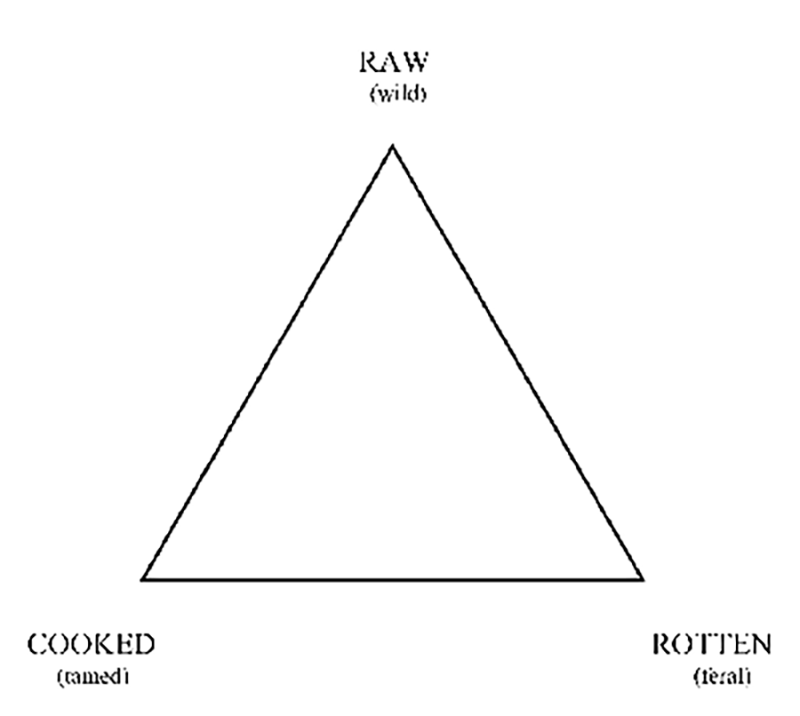My last post was triggered by Michael Scroggins’ mention of feral cats in Australia. It made me think of Lévi-Strauss’s culinary triangle as a way to escape simple dualisms. But they may not be sufficient if they induce readers to classify (some animals would be wild, others domesticates, and still other feral). It may be closer to Lévi-Strauss’s goal to imagine that any “thing” (food, animal, marriage, blog posts) is always, as produced through humanity, wild and domesticated and feral (or imaginative/conventional/confusing).
But the power of the triangles is best revealed when we lay the three poles on a temporal frame and imagine them as a sequence involving minimally three persons (Arensberg 1981, 1982).
imagination -> convention -> confusion
Let’s stay with any blog post (as I started in my last one). Like any other form of asynchronous expression, a post develops over a period of time, in the privacy of a writer’s room, one character at the time of a computer screen. ‘I’ am currently doing this (a post), and do not quite know what I will write next (at this very momentary moment, ‘I’ am often suspended, wondering whether to open a new parenthesis, or not).
But all this is not accessible to anyone but ‘me’ as, a few seconds later, I discover what ‘I’ wrote and may now edit. This next step may be taken hours, if not days, later. [note: this sentence was written on December 14, 2016; this note was written on January 9, 2017.] In other words, ‘I’ am conversing with ‘my self’, struggling with the words I must borrow, but without having to deal with anyone else who, at some future time, might tell I/me what I wrote.
And then, at some point, ‘I’ will press “Publish” and the post will escape into ‘my’ past, an uncertain future, and any reader’s present and then past.
All this, of course, is a common sense developed by American Pragmatists, most clearly perhaps by George Herbert Mead (1913, 1934), and later formalized in conversational analysis and related fields. I paraphrase this sense in this way:
‘I’ (in the radical present) becomes ‘me’ (as remembered in a system of identifications) and is then identified for all future purposes in a third move, possibly performed by some more or less significant other, alive or dead.
As Mead put it:
It is not necessary, in attempting to solve the problem of meaning, to have recourse to psychical states, for the nature of meaning, as we have seen, is found to be implicit in the structure of the social act, implicit in the relations among its three basic individual components: namely in the triadic relation of
1) a gesture of one individual
[and then]2) a response to that gesture by a second individual
[and then]3) completion of the given social act initiated
by the gesture of the first individual.
(Mead 1934: 78. I reformatted to emphasize sequentiality and added the italicized text)
Had Geertz built on Mead rather than Weber, he might have seen that his concern with “interpreting” twitches/winks is moot: the “meaning” is in a completion that is an act of power rather than of interpretation. That is, neither the gesture nor the response determine the completion. Rather the completion determines what happened before in that completion identifies the muscle spasm as this (rather than that): In culture causality is reversed.
Most anthropologists, of course, follow Geertz, following Weber. Few follow Arensberg (or Mead, or Garfinkel) in his insistence on sequencing and temporality (by contrast to the more common insistence on history). Those who did, say in the anthropology of schooling, or of science and technology, may, however, have fallen into another trap that thinking about the feral makes glaring. This trap involves assuming that the completing act as necessarily an act of identification back into the “normal-for-the-time” (culture as organization of political power producing particular forms of suffering). I’d now say that most of my work with McDermott could be criticized for assuming that completion silences possibilities opened by the gesture or the response to the gesture. We complained about Bourdieu, Foucault, et al., but more for their understanding of the processes of reproduction rather than for taking reproduction as inevitable—even though, as anthropologists, we should have known better. Even the most incessant work at reproduction will always fail. Even the most pampered of kittens can go feral.
Why this should be so should be the anthropological problem, to the extent that we follow our roots to Boas and Saussure (as historical linguist). I have written about “education” is this vain, but thinking about the feral as a moment rather than a category could sharpen the argument. One should wonder: what if “completion” is more akin to an apparently ‘domesticated’ cat escaping into the streets, hills and back-country? To the very extent that the completing act may surprise those who gestured and responded, then even an enforcement of the normal can become something to fight. That is every “third” (identifying “completion”) in temporality, is also a “second” (suitable “response”), and then or course a “first” (“gesture” wildly open to all sorts of responses).
In brief, the classical case borrowed from Hugh Mehan on classroom lessons (1979) is generally summarized as a sequence:
1) Question (gesture): “What time is it?”
2) Answer (response): “It’s 10:06″
3) Evaluation (completion): “Good! ‘A’ on finding the time on your computer screen!”
When I teach this sequence, I then note that the evaluation places the sequence into the world of meritocratic schooling and its attendant production of sanctioned inequalities.
I do not know of anyone noticing that teaching this sequence is actually a statement in a temporal sequence. That is, “teaching about schooling” (reporting, telling, …) is a new, altogether feral (from the point of view of about everyone involved in schooling), completing “third”:
1) Gesture: “It’s 10:06″
2) Response: “Good! ‘A’ on finding the time on your computer screen!”
3) Completion: “This is a terrible way of doing education!”
No wonder so many dismiss anthropology, or even try to silence it — like the government of Australia trying to rid the continent of feral cats!
References
Arensberg, Conrad. 1981 “Cultural holism through interactional systems.” American Anthropologist. 83:562-581
Arensberg, Conrad. 1982 “Generalizing anthropology: the recovery of holism,” in Crisis in anthropology. Edited by E. A. Hoebel, et al.. New York: Garland Publishing, Inc.. pp. 109-130.
Mead, G. H. 1934 Mind, self and society. Chicago: University of Chicago Press.
Mehan, Hugh 1979 Learning lessons: Social organization in the classroom. Cambridge, MA: Harvard University Press.
 Print This Post
Print This Post


